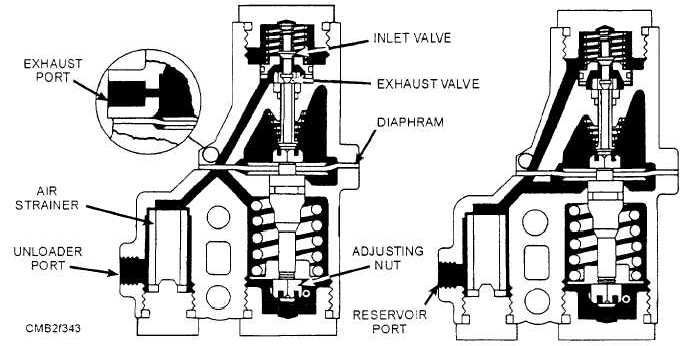valve and out the upper connection to the unloader assembly located in the compressor cylinder head. When the unloader valves open, the compression of air is stopped.
When reservoir pressure is reduced to the cut-in setting of the compressor governor (80 to 85 psi), the governor tube again exerts sufficient spring pressure on the valve mechanism to depress and close the lower valve and open the upper valve, thereby shutting off and exhausting the air from the compressor unloading mechanism and compression is resumed.
The pressure range and setting should be checked periodically using an air gauge known to be accurate. Pressure range may be changed in the type O-1 governor by adding shims beneath the upper valve guide to decrease the range, or removing shims to increase the range. Pressure settings may be changed, if necessary, by turning the adjusting screw to the left to increase the setting or to the right to decrease the setting.
The strainer should be removed periodically and cleaned. Check the governor periodically for excessive leakage in both the cut-in and cutout positions. If the governor fails to operate properly, it should be repaired or replaced.
In the type D governor (fig. 7-42) when the reservoir pressure reaches the cut-out setting (100 to 110 psi), the governor diaphragm is subjected to sufficient air pressure to overcome the spring loading.
This action allows the valve mechanism to move up, permitting the exhaust stem to close the exhaust valve and to open the inlet valve. Reservoir pressure then passes through the governor to operate the compressor unloading mechanism. stopping further compression of the air compressor.
When the reservoir pressure is reduced to the cut-in setting (80 to 85 psi). the spring loading within the governor overcomes the air pressure under the diaphragm. The valve mechanism is actuated, closing the inlet valve and opening the exhaust valve, thereby shutting off and exhausting the air from the compressor unloading mechanism and compression is resumed.
Pressure range and setting should be checked periodically, using an accurate air gauge. The pressure range (pressure differential) between loading and unloading of the type D governor is a function of the design of the unit and should not be changed. The designed range for this governor is approximately 20 percent of the cutout pressure setting. The pressure settings of the type D governor may be adjusted by turning the adjusting nut clockwise to increase or counterclockwise to decrease the settings.
Both strainers should be removed periodically and cleaned or replaced. The governor should periodically be checked for leakage at the exhaust port in both the cut-in and cutout positions. If the governor fails to operate properly, it should be repaired or replaced.

Figure 7-42. - Type D governor.
Continue Reading